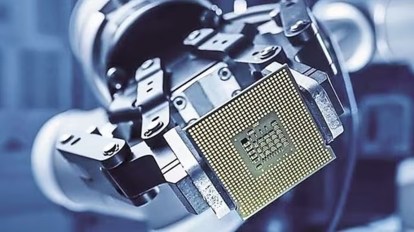Add your promotional text...
India’s Technological Leap: Semiconductors, Supercomputers, and Digital Excellence in 2024
Synopsis: In 2024, India achieved remarkable milestones in technology and manufacturing, solidifying its position as a global tech leader. This blog delves into India's advancements in semiconductor production, supercomputing, and digital literacy, highlighting key initiatives and their transformative impact.
VIEWS ON NEWS
By Monika Agarwal
12/27/20243 min read


India’s Tech Revolution: Setting the Stage for a Digital Future
The year 2024 marked a turning point in India's technological journey. From establishing advanced semiconductor manufacturing facilities to unveiling powerful supercomputers, the country made significant strides in innovation and infrastructure. These developments not only boost India's self-reliance but also pave the way for its emergence as a global technology hub.
Semiconductor Manufacturing: A Quantum Leap
India took a decisive step toward establishing itself in the global semiconductor ecosystem by approving several high-profile semiconductor manufacturing projects. These projects aim to reduce dependency on imports and position India as a major player in the global semiconductor supply chain.
1. Tata Electronics Private Limited (TEPL): Two Landmark Projects
Semiconductor Fab Facility:
Investment: ₹91,526 crore
Partnership: PSMC, Taiwan
Production Capacity: 50,000 wafer starts per month (WSPM)
This facility represents a game-changing initiative to enhance India's semiconductor manufacturing capabilities and technological expertise.
OSAT Facility:
Investment: ₹27,120 crore
Technology: Indigenous semiconductor packaging
Production Capacity: 48 million units per day
This facility focuses on Outsourced Semiconductor Assembly and Testing (OSAT), ensuring robust packaging solutions for India’s semiconductor needs.
2. CG Power and Industrial Solutions Limited
OSAT Facility:
Investment: ₹7,584 crore
Partners:
Renesas Electronics America, US
STARS Microelectronic, Thailand
Technology Providers:
Renesas Electronics Corporation, Japan
STARS Microelectronic, Thailand
Production Capacity: 15.07 million units per day
This facility underscores India's growing global partnerships in semiconductor manufacturing.
3. Kaynes Technology India Limited (KTIL)
OSAT Facility:
Location: Sanand, Gujarat
Investment: ₹3,307 crore
Technology: Wire bond interconnect, substrate-based packages
Production Capacity: 6.33 million chips per day
This project highlights India's strategic focus on diversifying its semiconductor capabilities and boosting local production.
Supercomputing Milestones: A Leap Toward Scientific Excellence
On September 26, 2024, Prime Minister Narendra Modi unveiled three cutting-edge Param Rudra Supercomputers, developed under the National Supercomputing Mission (NSM). These machines are set to revolutionize research and innovation across various disciplines.
The Supercomputers at a Glance
Inter-University Accelerator Centre (IUAC), New Delhi: 3 PetaFlops
Giant Metrewave Radio Telescope (GMRT), Pune: 1 PetaFlop
S.N. Bose National Centre for Basic Sciences, Kolkata: 838 TeraFlops
Impact on Research and Education
These supercomputers support over 10,000 researchers, including 1,700+ PhD scholars from 200+ institutions.
They facilitate groundbreaking studies in physics, earth sciences, and cosmology, further strengthening India’s academic and scientific landscape.
Boosting Electronics Manufacturing
Under the Scheme for Promotion of Manufacturing of Electronic Components and Semiconductors (SPECS), the government approved nine projects expected to generate 15,710 jobs. These projects align with India's vision to achieve self-sufficiency in electronics manufacturing while fostering innovation.
Digital Literacy: Empowering Rural India
The Pradhan Mantri Gramin Digital Saksharta Abhiyan (PMGDISHA) exceeded its target of training 6 crore individuals, achieving an impressive 6.39 crore. This initiative plays a crucial role in bridging the digital divide, empowering rural communities, and enabling millions to participate in India’s digital economy.
India’s Vision for a Tech-Driven Future
India's achievements in 2024 reflect a well-defined strategy to harness technology for economic growth and global leadership. Key takeaways include:
Strategic Investments: The government’s focus on semiconductors and supercomputing underscores its commitment to technology-driven self-reliance.
Global Collaborations: Partnerships with leading technology firms highlight India's appeal as a hub for innovation and manufacturing.
Inclusive Growth: Initiatives like PMGDISHA demonstrate a focus on empowering all sections of society in the digital age.
Looking Ahead: 2025 and Beyond
India’s tech landscape is poised for even greater milestones in 2025, with:
Expanded semiconductor production capacity.
Enhanced research capabilities through new supercomputing facilities.
Continued emphasis on digital literacy and skill development.
These advancements will solidify India's position as a global leader in technology and innovation, setting the stage for a prosperous and tech-driven future.
A New Era of Innovation
India’s technological achievements in 2024 signify a paradigm shift in its approach to innovation and infrastructure development. From semiconductors to supercomputers, the country is making bold strides toward becoming a global technology powerhouse.
With a clear vision, strategic investments, and robust policymaking, India is not just catching up but setting the pace for global technological leadership. As we step into 2025, the world will undoubtedly watch as India continues to redefine its digital and technological narrative.
Disclaimer: This blog is intended for informational purposes only.
